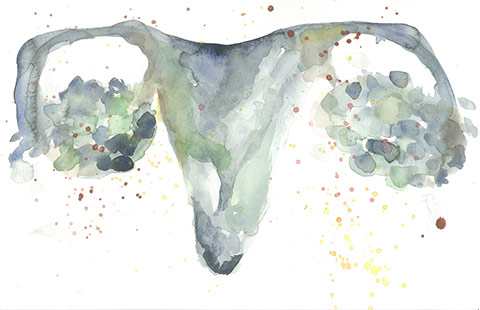Progesterone, also known as P4, is a reproductive hormone involved in the menstrual cycle. Influencing what is known as the “luteal phase”, it helps prepare the uterine lining for implantation. If implantation does occur, progesterone helps maintain the integrity of the endometrium, helping to secure the new pregnancy. It also plays a role in the development of an embryo.
Where does progesterone come from?
The first half of the menstrual cycle is referred to as the “follicular phase”. During this time, there is a proliferation of several ovarian follicles, each of which contains an egg. The largest of the follicles will eventually release an egg, a process called ovulation. After ovulation, the ruptured follicle turns into the corpus luteum.
The second half of the menstrual cycle is called the “luteal phase”. During this time, the corpus luteum produces increasing amounts of progesterone.
What does progesterone do?
After being released from the corpus luteum, this hormone enriches the uterine lining with glycogen, mucus, and other substances which support the embryo in the first stages of implantation. It also causes a woman’s core body temperature to rise by up to 0.5°C.
If implantation is successful, the embryo will secrete a hormone called human chorionic gonadotropin (HCG – the “pregnancy hormone”, detected in positive home pregnancy tests). HCG signals the corpus luteum to continue to produce progesterone, thus maintaining the uterine lining and the implanted embryo. If there is no implantation HCG will not be secreted, and the corpus luteum will break down. A disintegrating corpus luteum no longer produces enough hormones to maintain the uterine lining, causing it to break down and shed. This marks the beginning the next menstrual cycle.
Progesterone and In-Vitro Fertilization (IVF)
In an IVF cycle, a woman’s eggs are removed from her follicles with a long needle. They are then fertilized outside of her body before being returned to the uterus for implantation. In the process of egg removal, the follicles and corpus luteum are damaged. For this reason, women need to take an external source of progesterone so that the integrity of her uterine lining is maintained, and implantation can be successful.
What is a “Luteal Phase Defect”?
The time between ovulation and the beginning of menstruation should be 12 to 14 days. If it is shorter in duration than this, likely the corpus luteum is not producing enough progesterone to maintain the endometrium. Even if an egg is fertilized and becomes an embryo, if there is no support for the uterine lining a pregnancy cannot be sustained.
If a woman is charting her basal body temperature (BBT) to track her ovulation, she should see a rise in temperature just after ovulation, which stays elevated for 12 to 14 days. If her temperature drops suddenly or gradually before that time, the corpus luteum is not producing enough of the hormone.
A blood test on day 21 of a menstrual cycle (or, 7 days after ovulation) can reveal if the corpus luteum is producing enough progesterone to support pregnancy.
Can Chinese Medicine treat me during my luteal phase?
A short luteal phase, or a low basal body temperature after ovulation, is not ideal for fertility. It is important to remember that Traditional Chinese Medicine developed without the concept of hormones; in TCM theory, a luteal phase defect is seen as Kidney Yang deficiency. Warming the Kidney Yang and nourishing the Blood after ovulation with herbal medicine and acupuncture (and, wise lifestyle choices) will often result in a longer luteal phase and an elevated basal body temperature.
As with all of Chinese Medicine, it is important to consider a woman’s entire state of health and well-being when treating a luteal phase defect. Is there any evidence of poor circulation? An accumulation of phlegm or dampness? Inflammation? Warming Kidney Yang and nourishing Blood after ovulation is a good way to promote fertility in Chinese Medicine theory, but it is also important to clear out any pathogenic influences which may be interfering with the luteal phase.
One Chinese herb used often in the luteal phase is Shan Yao, or Chinese Yam. Also known as Dioscorea opposita, it produces large amounts of a steroid called diosgenin. Interestingly, today progesterone is manufactured from Dioscorea in laboratories.
If you would like to discuss your luteal phase and a potential hormone imbalance with Dr. Erin Flynn, please contact us today.
Dr. Flynn has also written about Estrogen in the Body: A TCM Perspective, if you would like to know more about hormonal imbalances.


